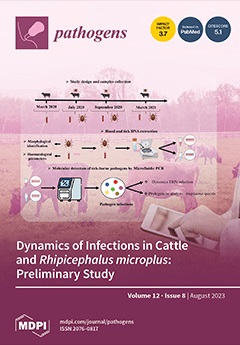View Item
- xmlui.general.dspace_homeCentros e Institutos de InvestigaciónCICVyA. Centro de Investigación en Ciencias Veterinarias y AgronómicasInstituto de BiotecnologíaArtículos científicosxmlui.ArtifactBrowser.ItemViewer.trail
- DSpace Home
- Centros e Institutos de Investigación
- CICVyA. Centro de Investigación en Ciencias Veterinarias y Agronómicas
- Instituto de Biotecnología
- Artículos científicos
- View Item
Transovarial transmission of anaplasma marginale in Rhipicephalus (Boophilus) microplus ticks results in a bottleneck for strain diversity
Abstract
Anaplasma marginale is an obligate intraerythrocytic bacterium of bovines, responsible for large economic losses worldwide. It is mainly transmitted by Rhipicephalus (Boophilus) microplus ticks and, despite mounting evidence suggesting transovarial transmission, the occurrence of this phenomenon remains controversial. We evaluated the vector competence of R. microplus larvae vertically infected with A. marginale to transmit the bacterium to a naïve
[ver mas...]
Anaplasma marginale is an obligate intraerythrocytic bacterium of bovines, responsible for large economic losses worldwide. It is mainly transmitted by Rhipicephalus (Boophilus) microplus ticks and, despite mounting evidence suggesting transovarial transmission, the occurrence of this phenomenon remains controversial. We evaluated the vector competence of R. microplus larvae vertically infected with A. marginale to transmit the bacterium to a naïve bovine. A subgroup of engorged female ticks collected from an A. marginale-positive animal was dissected and the presence of the pathogen in its tissues was confirmed. A second subgroup of ticks was placed under controlled conditions for oviposition. After confirming the presence of A. marginale in the hatched larvae, an experimental infestation assay was conducted. Larvae were placed on an A. marginale-free splenectomized calf. The bacterium was detected in the experimentally infested bovine 22 days post-infestation. We analyzed the A. marginale diversity throughout the transmission cycle using the molecular marker MSP1a. Different genotypes were detected in the mammalian and arthropod hosts showing a reduction of strain diversity along the transmission process. Our results demonstrate the vertical transmission of A. marginale from R. microplus females to its larvae, their vector competence to transmit the pathogen, and a bottleneck in A. marginale strain diversity.
[Cerrar]

Author
De La Fourniere, Sofia;
Guillemi, Eliana Carolina;
Paoletta, Martina;
Pérez, Agustina Ericlee;
Obregón, Dasiel;
Cabezas-Cruz, Alejandro;
Sarmiento, Nestor Fabian;
Farber, Marisa Diana;
Fuente
Pathogens 12 (8) : 1010 (Agosto 2023)
Date
2023-08
Editorial
MDPI
ISSN
2076-0817
Formato
pdf
Tipo de documento
artículo
Palabras Claves
Derechos de acceso
Abierto
 Excepto donde se diga explicitamente, este item se publica bajo la siguiente descripción: Creative Commons Attribution-NonCommercial-ShareAlike 2.5 Unported (CC BY-NC-SA 2.5)
Excepto donde se diga explicitamente, este item se publica bajo la siguiente descripción: Creative Commons Attribution-NonCommercial-ShareAlike 2.5 Unported (CC BY-NC-SA 2.5)


